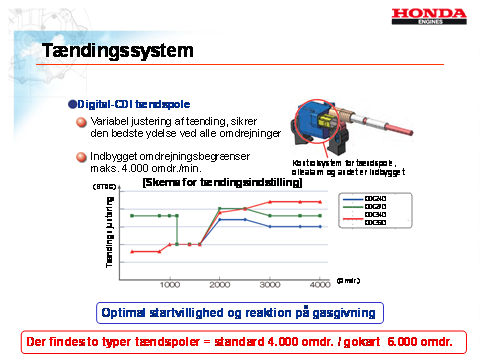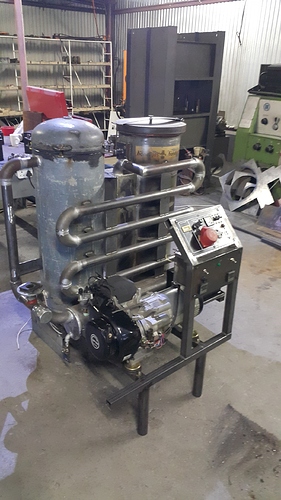Ive been working on Ben’s gasifier for 3 weeks now. Do anyone recomend installing flashback arrestors to the intake manufault? Ive tried starting the generator with a basic T air and fuel inlet and backfires back to the fuel inlet.
Im running a 9kva (13hp) petrol engine. Any advice would be apreciated.Im stil working on the electronic carburator
High Armand!
1.6.2019
Nice build, but the hardest possible to clean cooler.
Parallel tubes between two rectangular “boxes” and
a lift-off lid would be more “cleaning-practical” in the long run.
Compactness is for selling, not for maintenance!
The buyer is impressed, but the owner is depressed…
Max
I’ve never tried but I believe some fine mesh screen in a cone to give as much surface area as possible with the least amount of restriction should work to avoid a flash back.
Could it be your mixture is too lean?
Hi wallace, ive also seen stainless steel woll being used in a tube as a type of flashback arestor, im not realy shure if the gas mixture was too lean or not, currently busy with an electronic carb using an o2 sensor, hopefully this would get the mixture right
Hi max, thank you for commenting. The gasifier is based on the Ben Petersons gasifier design, except for the genarator frame asembly wich is easaly detacheble when doin maintenance. I understand the concern with acessibilty regarding cleaning and so on. Im building the gasifier for personal use, as i live in south africa. We realy do strugle with fuel and power outages due to load shedding.
A lean mixture will burn more slowly and its possible you have burning gasses in the chamber when you open the intake valve causing the flash back.
Yes I think very coarse wire wool will work so will metal screen for a flash back arrestor.
This ignition modual will work with your engine and can offer some timing retard for easier start up.
I think you may also have an issue with not enough timing and in a lean condition one problem will make the other worse
https://www.nrracing.com/category-s/2411.htm

Please supply a bit more information.
I see a hand-pull rope; and maybe an electric starter?
You really want to verify the engine capability on a specification fuel to rule out an engine problem.
THis can be done with bottled propane gas.
Put the propane bottle into a bucket of warm (NOT HOT!) water to insure a good from liquid-to-vapor supply.
The propane tip supply must be able to supply an adequate amount of propane gas. Small engines like this one I’ve been able to supply through a stock propane torch nozzle. Bigger engines had to go with a higher flow supply nozzle.
This engine at stopped governor default to a wide open throttle position. A gasoline carburetor with it’s internal venturi will still be able to low pressure create and suck/atomize the gasoline.
On a T-mixer replacement the wide open throttle not create enough intake suction. to pull in enough fuel
You can hand override the governor to throttle lever arm to close down some that throttle under cranking. Or build a choke flap onto the air-in side of the T-mixer.
Otherwise you will over-air run too fuel lean on cranking starting up; woodgas or gaseous propane.
Fuel lean mixed do cause intake back fires.
Regards on your efforts so far
Do realize all of this advice is to get your actual engine “workable” tested just to start-up and idle run on a know spec grade of fuel.
Engine grade testing your produced woodgas is a whole 'nother concern. Spark ignitable flare as a first step.
As Ben’s book specifies this engine loading is too small to demand-draw heat load that gasifier for best woodgas making performance. About 1/2 too small. You will have to work the fuel bits sizing and dryness then as a driven-needs primary concern.
See another members topic here about outside made charcoal fueling his Ben’s Book woodgasifier for his too small of engines. No conclusion success reported yet. But the DOW members exchanges to him will be instructive.
Note to all. Ben Peterson is a guy I’ve shoulder to shoulder worked with for a number of years.
His Book system is greatly simplified just to make it widest possible user build-able out of readily available materials. Get you up to making woodgas. Using woodgas in as wide as possible of personally owned&used engine applications. Your actual 'gitter-done using then. With your own actual local sourced wood fuel inputs as your training teacher.
He HAS made producer-gas to build-plastic/build a liquid fuel base feedstocks gasifiers. And sold this. Only one that I know of. The willing to shell out $50K are few-to-none.
He HAS made up two different vehicle systems. One sold. Big. Big legal problems here in WA State doing past one quietly used for personal use.
He has made dedicated gasifier systems for wood pellets, woodchips, charcoal to exclusively fuelgas power small single cylinder electrical generator engines. Sold many in diffident versions and configurations. Used as designed - ok to great! Not on rubber tire chunks, urban mixed plastics wastes, and paper shreds!! Not on forest floor duff full of fir, pine needles, leafs, and shits(manures)!!
My point?!
You using the right tool for the best purpose is YOUR choice. When the screwdriver you grab make’s a piss-poor hammer . . . who’s fault is that, eh?
This users wrong-choice try-forcing has driven both Jim Mason (APL) and Matt Ryder (Thrive Off Grid) nuts on many of their gasifier systems made-up and sold/deployed too.
Yep, MaxG.
I hate that serial flow single tube cooler too.
I have a BenP multi-parallel vertical tube cooler with rectangular upper and lower manifold boxes he made in about 2009 for compact usages. Stationary it need a fan to cool properly.
Ha! As I’ve said I can gas-cool/wash and condensate collect cool as well with a horizontal sloped 20 feet of old 4 inch ID cast iron soil (toilet drain) pipe. No fan. Just thermal air movement. And safely heat a work space with that. Just big, long. and cursed heavy. But easy clean&swab out with end caps.
S.U.
Steve Unruh
Oh.
On gas flow spark/flash back arresting:
the metallic screens, the metals fibers pack works by stopping ionization.
Proof.
Take that hand held propane torch.
Hold a fine grid metallic screen above the gas flow. Light/ignite the mix flow below the screen. Burning gasses do not extend up past above the screen.
Extinguish.
Repeat now lighting/igniting the mixed gasses flow above the screen. Combusting gases do not go down below the screen.
High school chemistry and welding classes, guys.
See-Doo; and believe.
Armand you already have a low flow problem you will be fighting with this small engine application to woodgas it. Adding more flow restriction in an arrestor screen will make that problem worse.
A four cylinder and above engine has the over-sizing needed to carry some flow restriction.
Regards
S.U.
Hi, Steve!
8.6.2019
Surface enough — low resistance enough!
Just having the installation volume…
To avoid soot-blocking, do the final filtering with reheated DRY gas and a paperfilter!
Max
Hi Max; Using what you recommend, we would have to pipe the finished gas ( after the hay filter) around something hot like the cyclone. Rather complicated. I thought of tapping off a 3/4 or 1 inch flexible gas pipe from the out let of the cyclone down to a cylinder after the hay filter with a “sock” filter in the cylinder. The gas out of the cyclone would be hot and warm the finished gas enough to get above the dew point. TomC
Hi, Tom!
8.6.2019
This proposal reminds me of an earlier one, with similar properties!
The relative cool gas comming out of the hayfilter is near or at it’s dew point.
It has dropped out a lot of condense during its cooling down from the output temperature at the cyclone.
Now you propose to add hot sooty gas from the cyclone, which HAS NOT YET dropped out any condense.
This extra humidity (still steam) will add to the total water amount in the already at condesation level beeing hay-filtered gas.
A saturated (wet) cool gas will be “enriched” with more water as the hot “cyclone gas” starts to go down to its condensation temperature, before reaching the motor compartment.
So in the end the hot “cyclone gas” will deliver more water than the “hay-filter gas” ( which has already separated a lot of condense)
Wet + Wet in the end does not make dry!
I thougt that this was sorted out already last time?
Then, the flame extinguiser should be as near to the intake manifold as possible; to provide as little as possible of air-mixed gas.
Same thing as before…
Max
Hi Max glad too see your still bucking the bull. I caint recall the temp on your hot filter though i think it is max about 275 f degrees depending on the filter type. ARE you thinking steel wool hot filter after the hay filter 100 percent. I supose it should be easyly removable filter. I caint remember
you said you had tried that design yet. Thanks.K
Hi, Kevin!
9.6.2019
Who would put a steel wool ( soft iron ) filter in the wet gas-stream after the hay-filter?
At least not me!
Hi Max hope your doing good feeling good, I probly miss read the study as usuall. I was thinking about your hot filter set up after the heated mantel, I caint remember if you recomended papper filter or ss mesh after reheating the fuel gas after the hopper. How is your wood power car running, are you still driveing around on wood.
Thank you, Kevin!
9.6.2019
The Audi needs new front wheel brake disks for next inspection, othervise OK.
Every filter needs consideration of the circumstancies it has to “deal with”.
One cannot apply a “dry working” filter in a “wet working” spot!
A wet gas can be re-heated for working in a paper filter, if the wet gas temperature allows re-heating to levels suitable for paper filters, for example…
Max
Your Welcom Max, the hot filter idea seems like good plan too try Asap when time gets avaiilable.Thanks.
Thank you Max for the reply; My memory is not good so apologize if my question was redundant. I do appreciate your answer. You saved me some useless work. My easiest alternative would be to run the gas pipe going to the engine parallel with the exhaust gases probably in a third container. Then going to an OE paper filter at the engine. Good to have you back. Tomc
Hi, Tom!
10.6.2019
If you intend to dry the wet gas after the hayfilter, the nearest hot point
(which also is the first to get hot at start up)
is the cyclone before the cooling racks!
Wrap and weld a mantel around that cyclone ! That is more comfortable to reach, than any low down places.
How about contiuing on you own site, instead of hanging here?
